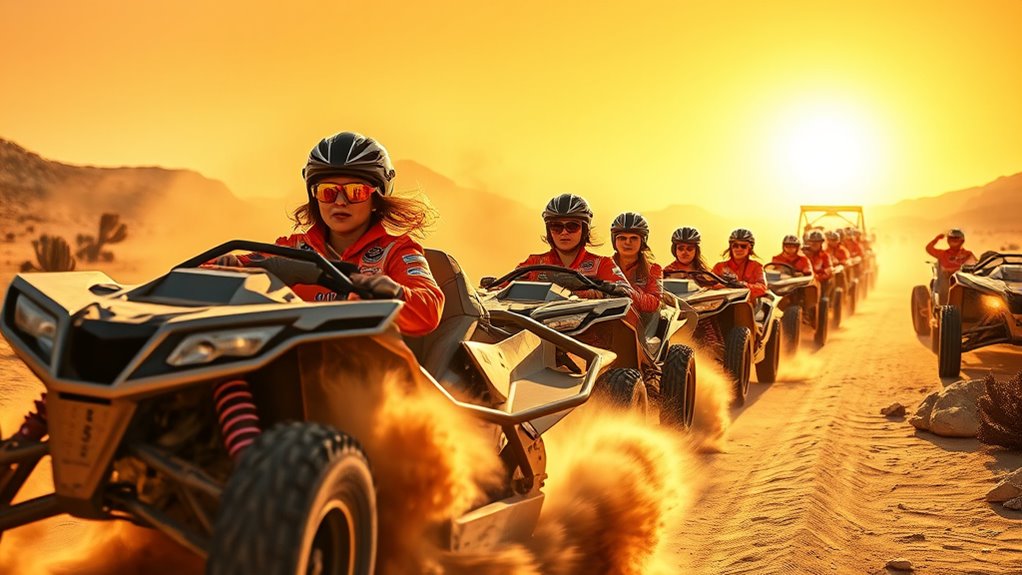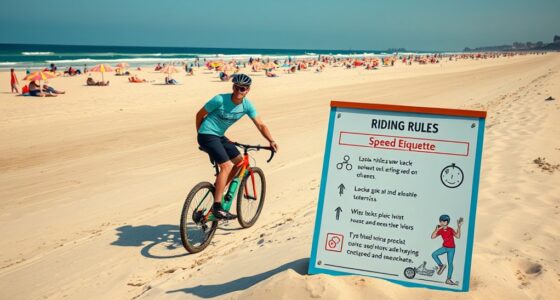Women pioneers in high-speed desert racing have broken barriers and challenged stereotypes, proving that skill and courage matter most. From trailblazers like Jutta Kleinschmidt to Cristina Gutiérrez, they’ve won prestigious races and inspired generations. Despite facing skepticism and tough obstacles, these women have innovated and persevered, transforming the sport into a more inclusive and dynamic arena. Keep exploring, and you’ll discover even more about their remarkable achievements and ongoing impact.
Key Takeaways
- Women like Jutta Kleinschmidt and Cristina Gutiérrez broke barriers with top finishes in male-dominated desert races.
- Female racers faced skepticism and limited opportunities but proved their skill through perseverance and innovation.
- Their achievements challenged gender stereotypes, inspiring future generations and promoting diversity in desert racing.
- Women drivers employ adaptive navigation, vehicle modifications, and advanced technology to succeed in high-speed terrains.
- Their pioneering efforts have contributed to making desert racing more inclusive, dynamic, and recognition-driven for women.
Breaking Barriers: The Early Trailblazers
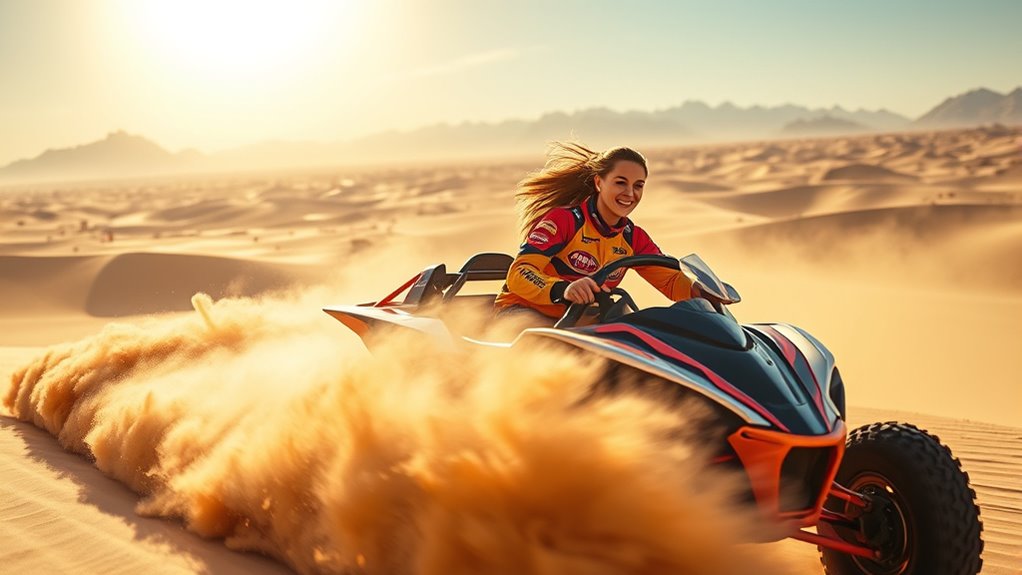
Although women faced significant obstacles in the male-dominated world of high-speed desert racing, a few trailblazers refused to be held back. They challenged stereotypes and pushed boundaries, proving that gender wasn’t a barrier to speed and skill. These early pioneers often had to fight for recognition, facing skepticism from racers and organizers alike. Despite limited resources and support, they trained tirelessly and competed fiercely, earning respect through determination and talent. Their courage opened doors for others and showed that women could excel in this extreme sport. These trailblazers not only raced against the desert but also against societal expectations, carving a path for future generations of women in high-speed racing. Their legacy remains a testimony to perseverance and breaking barriers. Their stories continue to inspire new generations to challenge norms and pursue their passion for speed and adventure.
Dominating the Desert: Notable Race Winners
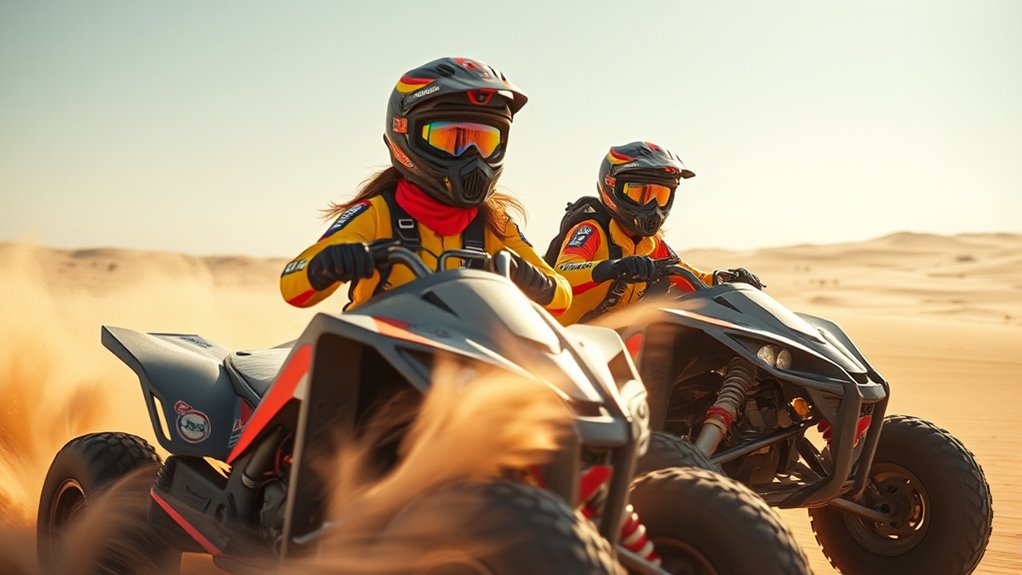
Women have made remarkable marks in high-speed desert racing by not only breaking barriers but also dominating the sport through sheer skill and determination. You’ve seen racers like Jutta Kleinschmidt, who won the Dakar Rally in 2001, proving women can conquer the toughest terrains. Others, like Cristina Gutiérrez, have consistently challenged the status quo, earning top finishes and respect from peers. These women push boundaries, mastering navigation, vehicle control, and endurance. They compete against seasoned veterans and often come out on top, showcasing that gender isn’t a limiting factor in this high-adrenaline environment. Their successes inspire future generations, proving that with talent and perseverance, women can and do dominate desert racing. Their victories redefine what’s possible behind the wheel. Additionally, their achievements highlight the importance of reliable resources and community support that empower women to excel in traditionally male-dominated sports.
Overcoming Challenges in a Male-Dominated Arena
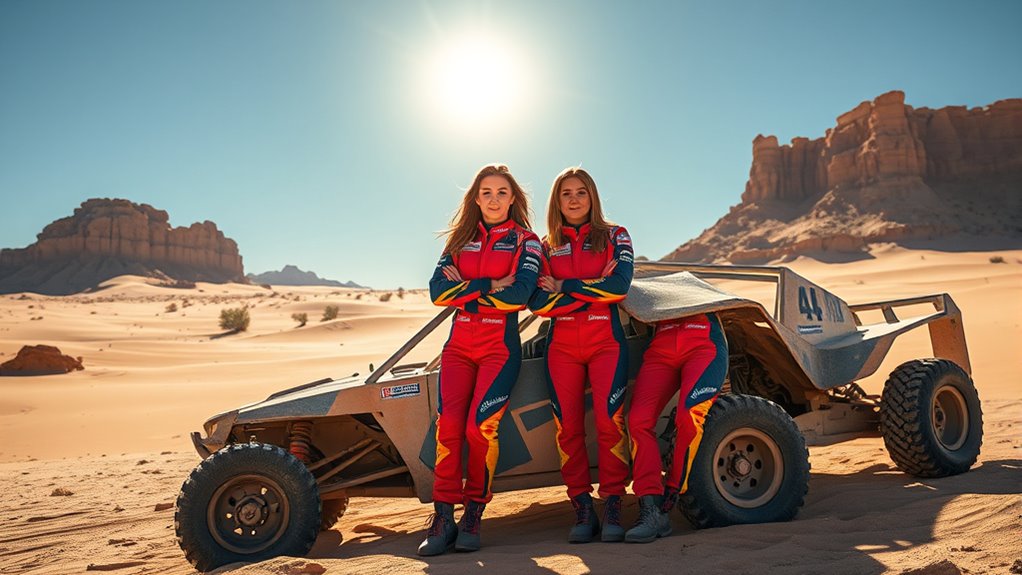
Breaking into a male-dominated desert racing scene requires resilience and determination, as women often face skepticism, stereotypes, and limited opportunities. You might encounter doubts about your skills or be underestimated simply because of your gender. To succeed, you need to:
- Break stereotypes by proving your competence through consistent performance.
- Build a supportive network of allies and mentors who believe in your potential.
- Persist despite setbacks, using failures as learning opportunities.
- Emphasize the importance of color accuracy in your equipment choices to ensure clear and precise visuals during races, which can boost confidence and performance.
You’ll also face cultural attitudes that question your presence in this high-speed world. Staying focused, confident, and prepared helps you overcome these hurdles. Remember, every challenge is a chance to demonstrate your passion and skill. Your perseverance can pave the way for future women racers to follow.
Innovations and Strategies of Women Drivers
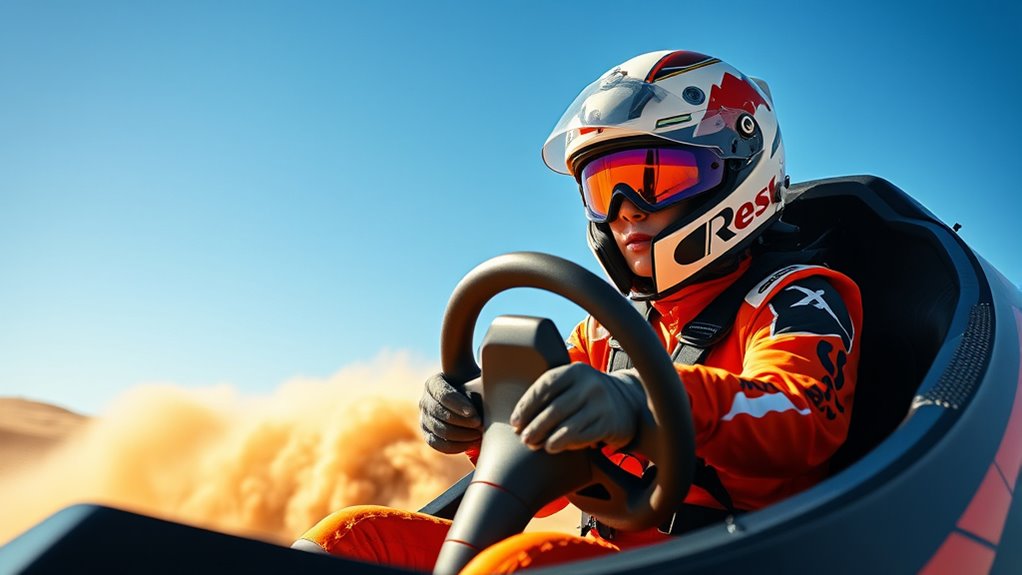
Women drivers develop innovative navigation techniques to stay ahead in tough terrain, relying on keen instincts and new tools. They also implement cutting-edge vehicle modifications to improve performance and safety in extreme conditions. These strategies showcase their ability to adapt and push the limits of desert racing. Additionally, their family support systems often play a crucial role in their resilience and success in this demanding sport.
Adaptive Navigation Techniques
To navigate the unpredictable terrain of high-speed desert racing, drivers rely on innovative adaptive techniques that enhance their responsiveness and safety. You master these strategies to stay ahead and avoid hazards. Here are three key techniques women drivers use:
- Real-time terrain assessment: Constantly scanning and adjusting to changing landscape features to choose the safest path.
- Dynamic throttle control: Modulating acceleration to maintain traction and stability over rough surfaces.
- Adaptive braking systems: Using responsive braking adjustments to handle sharp turns and sudden obstacles effectively.
- Incorporating crochet techniques for locs allows drivers to craft customized protective gear that improves comfort and safety during rugged races.
These techniques allow you to react swiftly to unexpected conditions, ensuring safety and maintaining speed. Women drivers have pioneered these adaptive methods, transforming how desert racing navigates its most challenging terrains.
Cutting-Edge Vehicle Modifications
Innovative vehicle modifications have become essential tools for women drivers looking to push the limits of desert racing. You customize your vehicles with lightweight materials, such as carbon fiber, to enhance speed and agility. Upgraded suspension systems improve handling over rough terrain, while reinforced chassis protect against impacts. Advanced tire technology offers better traction and durability on shifting sands. You also install high-performance cooling systems to prevent overheating during intense races. Electronic aids, like GPS navigation and telemetry systems, help you monitor your vehicle’s performance in real time. These modifications allow you to adapt quickly to challenging conditions and maintain a competitive edge. Additionally, understanding vehicle organization and proper maintenance routines ensures optimal performance throughout the race. By embracing these innovations, you maximize your vehicle’s capabilities, ensuring safer, faster, and more efficient desert racing experiences.
Inspiring Stories of Resilience and Courage
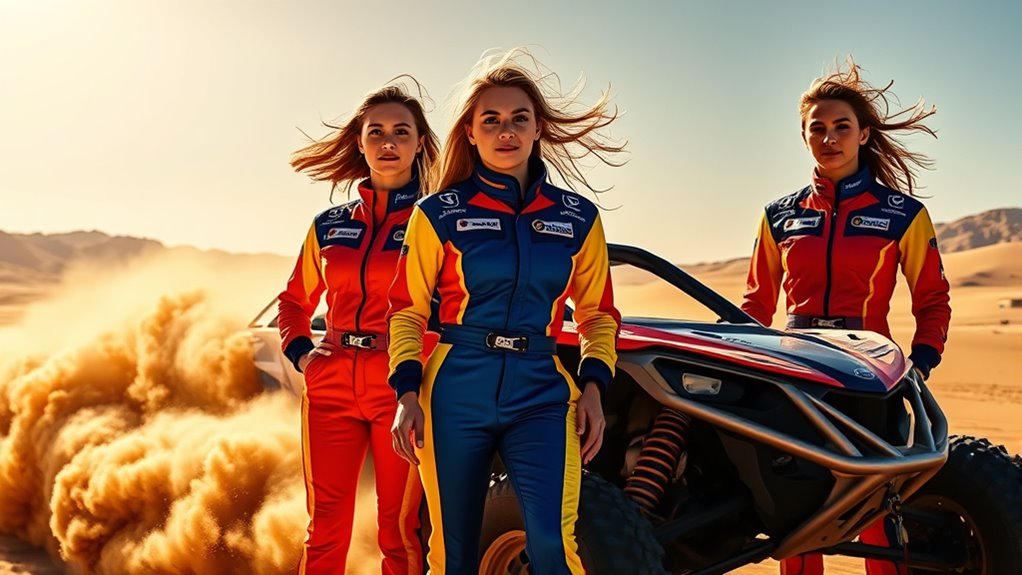
Despite facing numerous obstacles in a male-dominated sport, these women have demonstrated remarkable resilience and courage that inspire others to push beyond limits. Their stories show how determination turns setbacks into comebacks. For example:
- Overcoming injury to race again, proving strength and perseverance.
- Breaking barriers by winning championships despite doubts and bias.
- Balancing family life and intense training, showcasing your unwavering commitment.
- Embracing safety precautions and proper equipment use to prevent injuries and ensure longevity in the sport.
Their journeys remind you that resilience isn’t just about winning; it’s about fighting through adversity with courage. These women refuse to give up, inspiring countless others to chase their dreams regardless of challenges. Their bravery lights the way for future racers, proving that perseverance and guts can lead to extraordinary achievements.
The Impact of Women’s Participation on the Sport
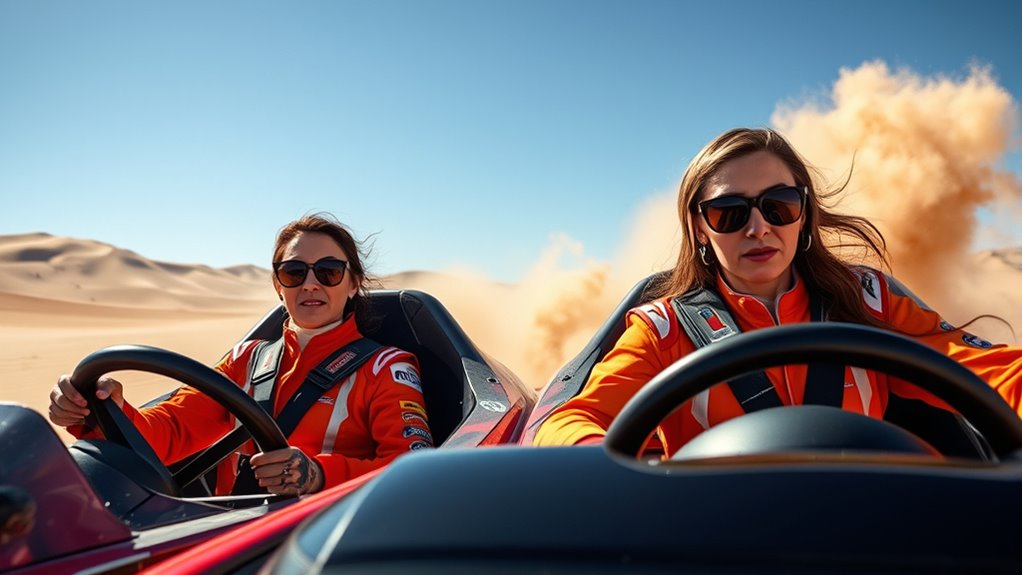
Women’s participation in high-speed desert racing has transformed the sport by introducing new perspectives, skills, and determination that challenge traditional norms. Your involvement has pushed boundaries, inspiring greater inclusivity and diversity within the racing community. As women take on demanding terrain and high-pressure situations, they demonstrate resilience and adaptability, raising the overall level of competition. Their presence encourages teams to rethink strategies, embrace innovation, and foster teamwork. This shift also attracts new audiences, broadening the sport’s appeal and breaking stereotypes that once limited participation. Through your achievements and perseverance, you’ve helped reshape perceptions of what’s possible in desert racing, proving that skill, courage, and passion know no gender. Your influence continues to drive progress, making the sport more dynamic and inclusive for everyone.
Future Directions for Women in Desert Racing
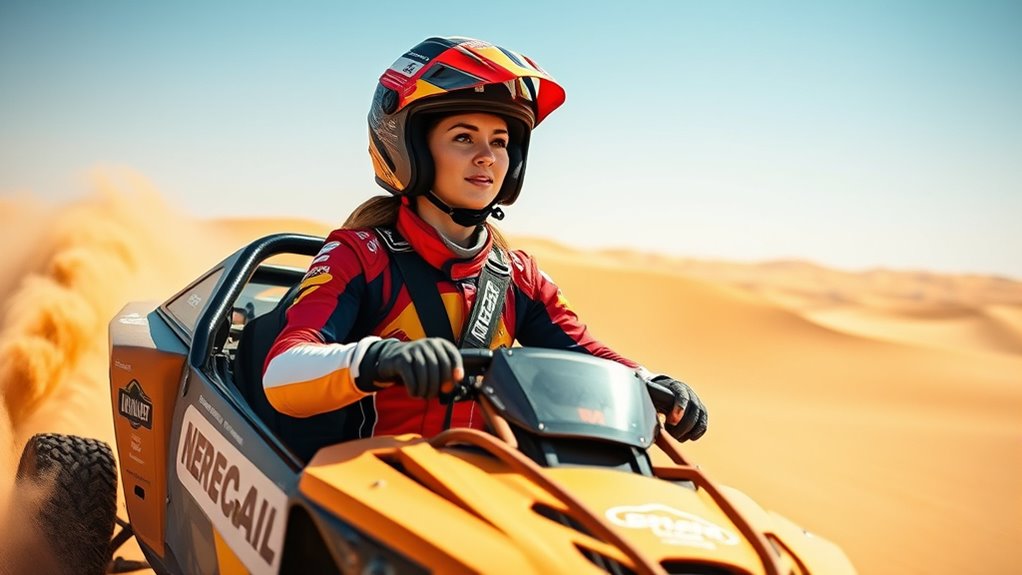
Looking ahead, the future of women in desert racing holds promising opportunities for growth and increased influence. Your involvement can drive significant change by:
- Breaking barriers through leadership roles in teams and organizations
- Promoting diversity and inspiring more women to get involved
- Advancing safety standards and technology with your unique perspectives
- Utilizing effective composition techniques to craft compelling narratives around women’s achievements in the sport
As more women demonstrate skill and determination, you’ll see increased media coverage and sponsorship opportunities. This visibility encourages younger generations to pursue their passion for desert racing. You can also advocate for inclusive policies that support women racers at every level. By actively participating and leading, you’ll shape a more equitable landscape. Your journey can inspire a new wave of women to push boundaries and redefine what’s possible in high-speed desert racing.
Frequently Asked Questions
How Do Women Prepare Physically and Mentally for Desert Racing?
To prepare physically and mentally for desert racing, you focus on building strength, endurance, and agility through regular cardio, strength training, and practice runs. Mentally, you develop resilience by visualizing races, managing stress, and staying focused under pressure. Proper nutrition and hydration are essential, and you also work on maintaining a positive mindset. This combination helps you stay sharp, confident, and prepared for the intense demands of high-speed desert racing.
What Specific Safety Measures Are Tailored for Women Drivers?
Think of safety measures as your armor on the racecourse. For women drivers, tailored safety includes ergonomic harnesses that fit comfortably, reinforced seats designed for female physiques, and advanced communication systems to keep you connected. Specialized training focuses on handling gender-specific challenges, while custom fire-resistant suits offer added protection. These measures symbolically shield you, empowering your confidence and resilience as you conquer the desert’s fierce terrain.
How Has Media Coverage of Women in Desert Racing Evolved?
You’ve likely noticed how media coverage of women in desert racing has grown more diverse and inclusive over time. Initially, stories focused on gender differences, but now, you see women highlighted for their skills, determination, and achievements. Media outlets increasingly showcase their success stories, breaking stereotypes and inspiring others. This evolution encourages more women to participate, fostering a stronger, more equal racing community that recognizes talent beyond gender.
What Sponsorship Opportunities Are Available for Women Racers?
You can find various sponsorship opportunities for women racers, including corporate brands, gear companies, and local businesses enthusiastic to support female talent. Reach out with a professional proposal showcasing your skills and passion. Many organizations now actively seek to diversify their sponsorships, so highlighting your achievements and community involvement can attract sponsors. Building a strong social media presence and networking within racing communities also open doors to valuable sponsorship deals.
How Do Women Mentors Influence Future Generations in the Sport?
You can see that women mentors play a essential role in shaping future generations by offering guidance, support, and shared experiences. They inspire you to push boundaries and believe in your abilities. Mentors also provide practical advice, help build confidence, and create a sense of community. By seeing successful women in the sport, you’re encouraged to pursue your passions, fostering a stronger, more diverse racing community for the future.
Conclusion
Just like the fearless adventurers of old who charted unknown territories, you’re part of a legacy that continues to break barriers. Women in high-speed desert racing prove that with courage and innovation, you can defy expectations and rewrite history. Keep pushing boundaries, because, as the trailblazers before you showed, victory belongs to those who dare to venture into the wild unknown. Your journey inspires others to chase their own desert dreams.
